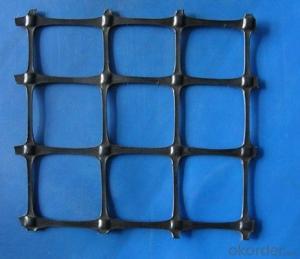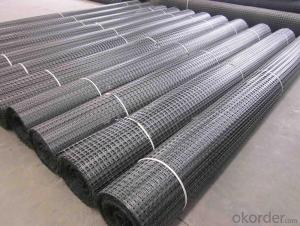Biaxial Extruded Geogrids - Biaxial Tensile Plastic Geogrid for Sale Made in China
- Loading Port:
- Qingdao
- Payment Terms:
- TT OR LC
- Min Order Qty:
- 30000 m²
- Supply Capability:
- 500000 m²/month
OKorder Service Pledge
OKorder Financial Service
You Might Also Like
Structure of Biaxial Tensile Plastic Geogrid:
Biaxial Tensile Plastic Geogrid is a kind of new favorable earthwork base material to strengthen the road surface and roadbed.This product is made by weaving and covering fiberglass filament. It is featured by high vertical and horizontal tensile strength, low unit extension, high flexibility, and favorable high and low temperature resistance. Widely used in the reinfircement of asphalt pavement, cement pavement and roadbed, as well as railroad bed,embankment revement, airport runway, and the prevention and control of desertification.
Main Features of Biaxial Tensile Plastic Geogrid:
fiberglass geogrid for soil reinforcement
Reinforcement of the surface of road and bridge.
High tensile strength, low elongation
Dyke reinforcement on soft ground for stress evenness,sedimentation adjustment,increase of stability and loading capacity of fundus;
Biaxial Tensile Plastic Geogrid Images



Biaxial Tensile Plastic Geogrid Specification
Polyester Geogrid GGF80 Technical Specification | |||
Property | Test Method | Unit | Index |
Wide Width Tensile Strength | |||
MD | KN/M | ≥80 | |
CMD | KN/M | ≥80 | |
Elongation At Break | ≤4 | ||
Grid | MM | 25.4×25.4 | |
Width | M | 1~6 | |
Packaging | Details | ||
Roll Dimensions(W×L) | According to customer requirements | ||
Square Meters Per Roll | |||
Estimated Roll Weight | |||
It is widely used in Asphalt wall, railway foundation, dike slope, runway and sand harnessing.
FAQ
We have organized several common questions for our clients,may help you sincerely:
Q: How about your company?
A:Our company are one of the largest geosynthetic products supplier in the world.We have the products experience more than 20 years.Already export to USA/Germeny/Australia/Zambia/Brazil etc.more than 20 countries.Almost 10years.Our products including Geocell/Fiberglass Geogrid/Geomembrane/Geotextile/Geonet etc.
Q.Does your products have good qualitity?
A:Yes,we have do many big projects such as the 2008 Beijing Olympic BIRD NEST. Divert water from the south to the north project. And our products have CE certificate also.
Q:How long can we receive the products after purchase?
A:In the purchase of product within three working days, We will arrange the factory delivery as soon as possible. The pecific time of receiving is related to the state and position of customers.Commonly 15-20 working days can be delivery.
- Q: Are geogrids suitable for use in cold climates?
- Yes, geogrids are suitable for use in cold climates. Geogrids are made from materials that are resistant to temperature variations and have been designed to withstand the harsh conditions of cold climates. They provide excellent reinforcement and stabilization for soil and are commonly used in various applications such as road construction, retaining walls, and erosion control in cold regions.
- Q: How do geogrids improve the performance of geogrid-reinforced earth walls?
- Geogrids improve the performance of geogrid-reinforced earth walls by providing tensile strength and stabilizing the soil, which helps to prevent the wall from sliding or collapsing. They distribute the forces exerted on the wall more evenly, reducing stress concentration and increasing overall stability. Additionally, geogrids enhance drainage and soil compaction, further enhancing the wall's performance.
- Q: Are geogrids compatible with different soil types?
- Yes, geogrids are generally compatible with different soil types. Geogrids are versatile materials that can be used with various soil types, including clay, sand, and gravel. They are designed to provide reinforcement and stability to the soil, improving its load-bearing capacity and preventing erosion. However, the specific type and design of the geogrid may vary depending on the soil characteristics and engineering requirements of the project.
- Q: Geogrid standard geogrid price geogrid role
- Geogrid is a kind of main geosynthetics, which has unique properties and effects compared with other geosynthetics. Geogrid is often used as reinforcement of reinforced soil structure or composite material. Geogrid is divided into four categories: plastic geogrid, steel plastic geogrid, fiberglass geogrid and fiberglass polyester geogrid. Geogrid is a kind of main geosynthetics, which has unique properties and effects compared with other geosynthetics. Geogrid is often used as reinforcement of reinforced soil structure or composite material. Geogrid is divided into four categories: plastic geogrid, steel plastic geogrid, fiberglass geogrid and fiberglass polyester geogrid.
- Q: Glass fiber grille material.
- Glass fiber grille is made of glass fiber
- Q: What is the recommended geogrid aperture size?
- The recommended geogrid aperture size depends on various factors such as the specific application, soil conditions, and engineering requirements. It is best to consult with a geotechnical engineer or a specialist in geogrid design to determine the appropriate aperture size for a particular project.
- Q: Are geogrids suitable for use in mechanically stabilized earth walls?
- Yes, geogrids are suitable for use in mechanically stabilized earth walls. Geogrids are commonly used in these types of structures as they provide reinforcement and enhance the stability of the earth walls. They help distribute loads and improve the overall strength of the structure, making them a suitable choice for mechanically stabilized earth walls.
- Q: Are geogrids effective in erosion control?
- Yes, geogrids are effective in erosion control. They provide stability and reinforcement to soil, preventing erosion by holding the soil in place and reducing the movement of sediments. Geogrids also improve the load-bearing capacity of the soil, making them suitable for various erosion control applications such as retaining walls, slopes, and embankments.
- Q: Can geogrids be used in road construction?
- Yes, geogrids can be used in road construction. Geogrids are commonly used in road construction to reinforce the pavement layers and improve the overall strength and stability of the road. They help to distribute the load more evenly, reduce the potential for cracking and rutting, and enhance the lifespan of the road.
- Q: Glass fiber mesh and geogrid which is good
- Main production, geotextile, geogrid, geomembrane, bentonite waterproof blanket
Send your message to us
Biaxial Extruded Geogrids - Biaxial Tensile Plastic Geogrid for Sale Made in China
- Loading Port:
- Qingdao
- Payment Terms:
- TT OR LC
- Min Order Qty:
- 30000 m²
- Supply Capability:
- 500000 m²/month
OKorder Service Pledge
OKorder Financial Service
Similar products
Hot products
Hot Searches
Related keywords


































